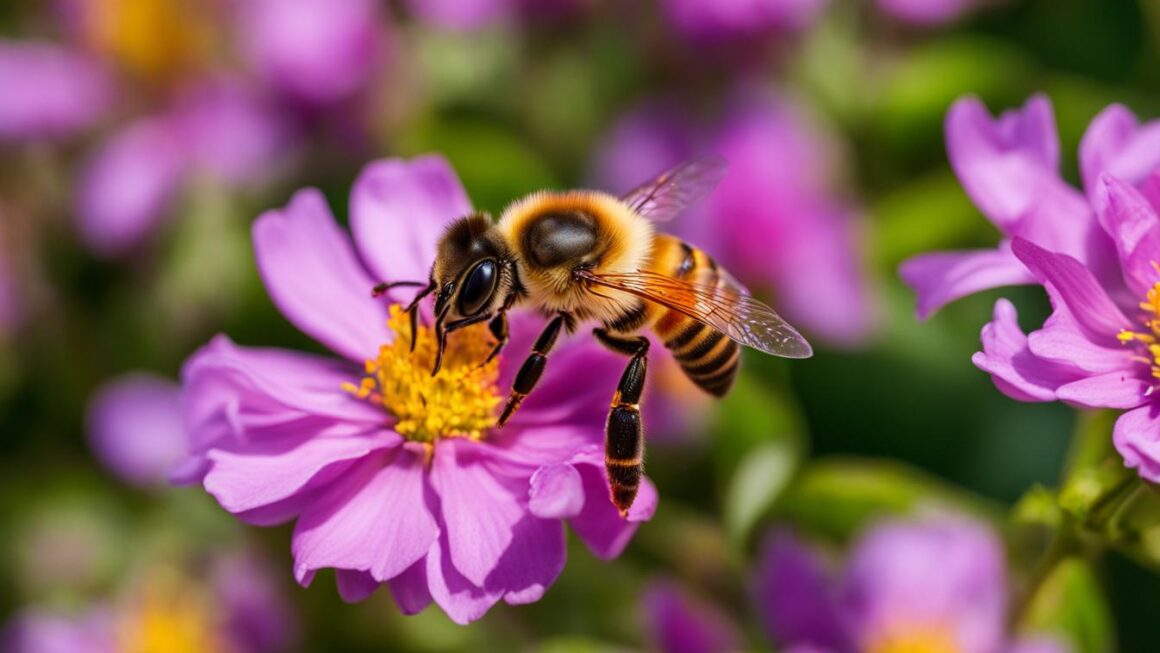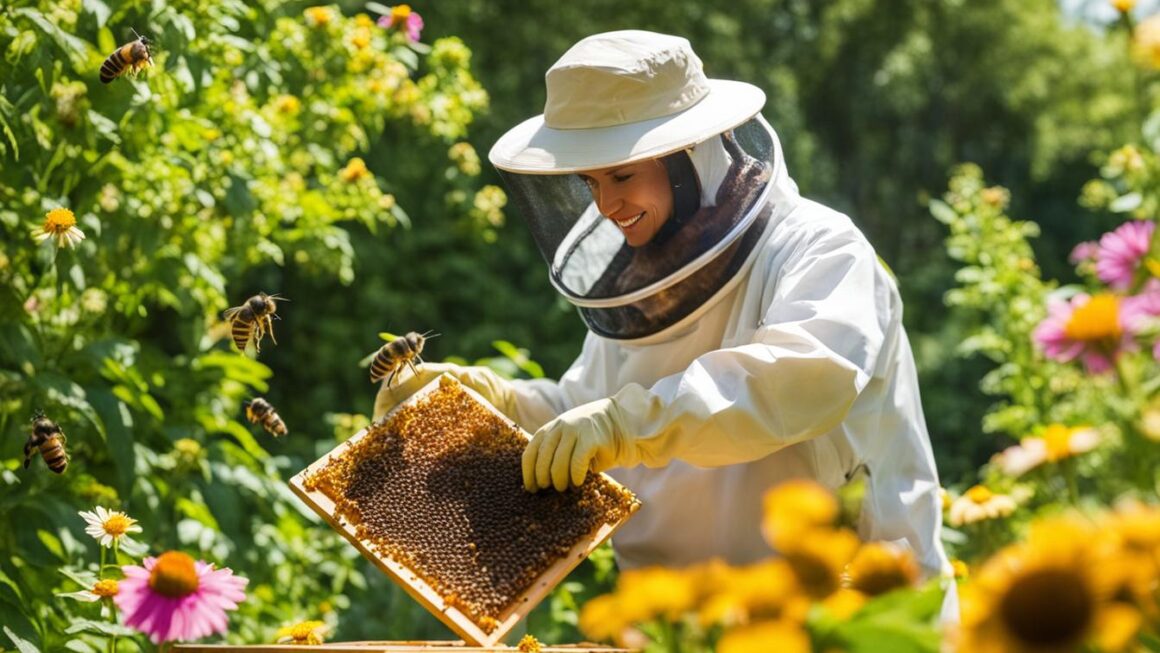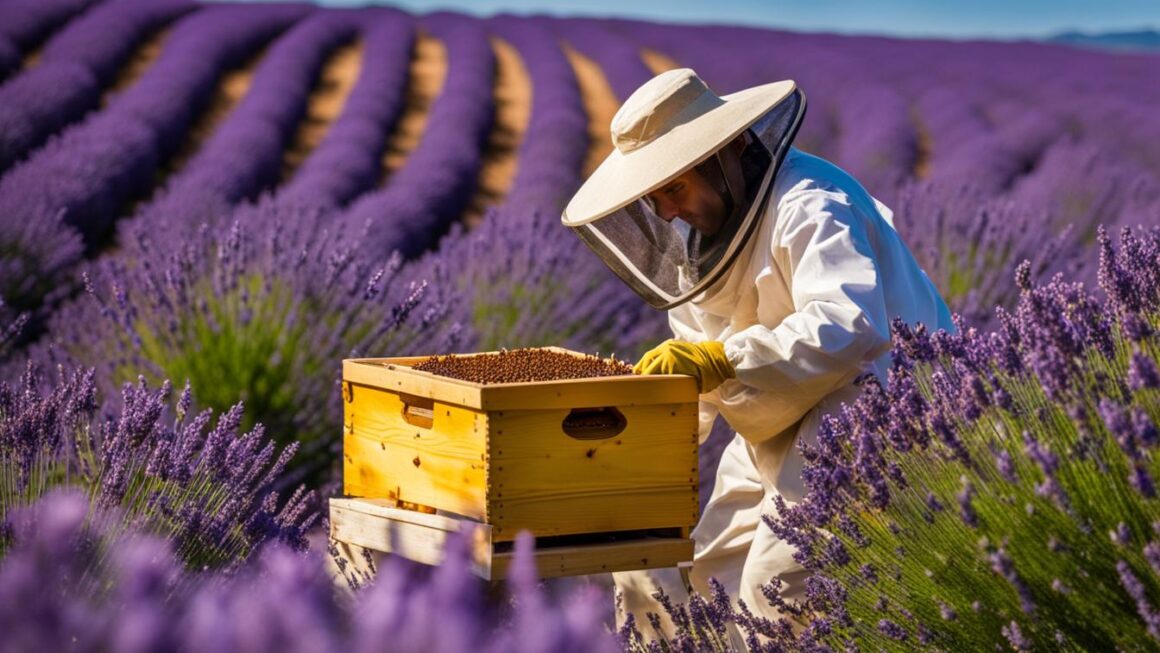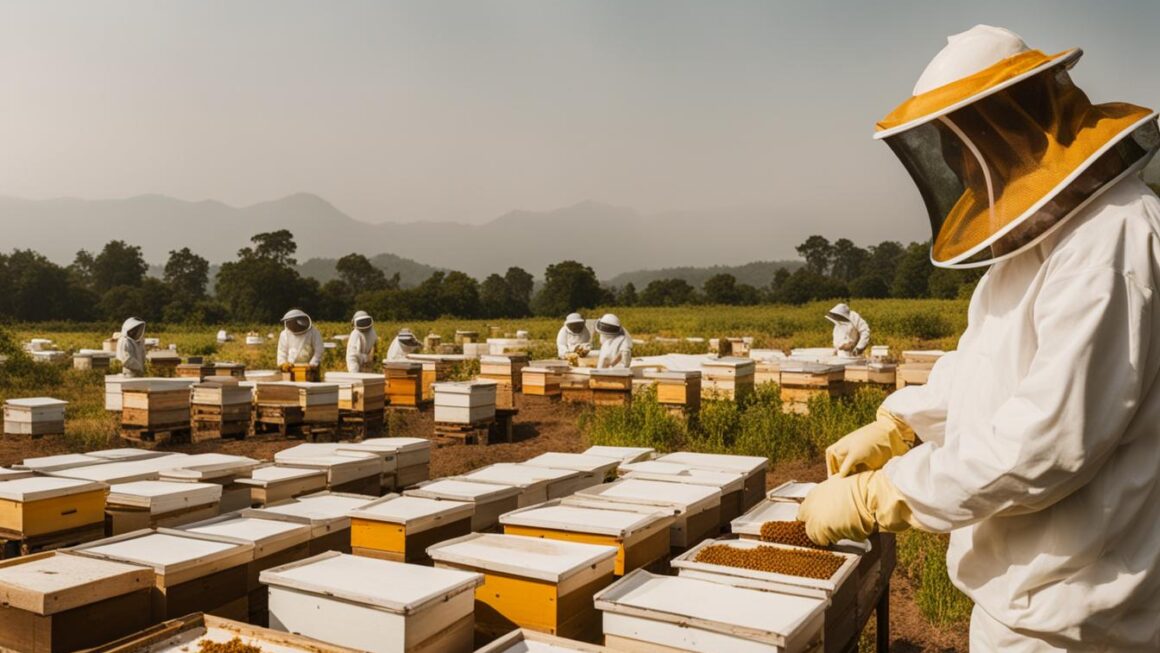Bees play a vital role in pollination, which is the transfer of pollen from the male parts of a flower to the female parts. This process is essential for the fertilization of plants and the production of seeds. Bees, especially European honey bees, are the primary insect pollinators, but there are also hundreds of other species of bees that contribute to pollination. Bees collect pollen as a source of protein and carry it back to their nests. They focus on one type of flower at a time, ensuring that pollen from one flower is transferred to another flower of the same species. This type of pollen distribution, known as cross-pollination, is necessary for the production of viable seeds. Bees are attracted to flowers that offer nectar as a reward, and they use their specialized brushes and body parts to collect and transport pollen. Without bees and their diligent efforts in collecting pollen, the ecosystem would suffer, and our food supply would be greatly impacted.
Key Takeaways:
- Bees are essential for pollination, transferring pollen between flowers for fertilization and seed production.
- European honey bees are the primary insect pollinators, but many other species of bees also contribute to pollination.
- Cross-pollination, where pollen is transferred between flowers of the same species, is crucial for the production of viable seeds.
- Bees collect pollen as a source of protein and use specialized brushes and body parts to carry and transport it.
- Bees play a vital role in maintaining the ecosystem and ensuring a stable food supply.
The Importance of Bees in Pollination
Bees play a crucial role in pollination, making them indispensable to the health and productivity of ecosystems. As highly efficient pollinators, bees spend a significant amount of time collecting pollen, which serves as a vital source of nutrition for themselves and their offspring. Through their foraging behavior, bees ensure the transfer of pollen between flowers, enabling the fertilization of plant ovaries and the production of seeds. This process, known as cross-pollination, is essential for the survival and genetic diversity of many plant species.
One of the key benefits of bees collecting pollen is their efficiency in focusing on one type of flower at a time. By doing so, they increase the chances of cross-pollination between flowers of the same species, ensuring the production of viable seeds. This not only supports the reproduction of plants but also plays a vital role in the growth and abundance of crops such as fruits, vegetables, nuts, and seeds. Without the diligent efforts of bees in collecting pollen, the cultivation of these crops would be significantly impacted, leading to potential food shortages and economic losses.
The importance of bees in pollination extends beyond crop production. Bees also contribute to the maintenance of natural plant communities and the overall biodiversity of ecosystems. As they collect pollen and nectar from flowers, bees inadvertently transfer pollen from one flower to another, facilitating genetic diversity within plant populations. This genetic diversity is essential for the survival and adaptation of plant species, as it allows for the creation of hybrid or new species that can better withstand environmental changes. Additionally, bees serve as a crucial food source for other animals, including birds and mammals, further supporting the balance and stability of the entire ecosystem.
In conclusion, bees play a vital role in pollination, ensuring the reproductive success of flowering plants and the sustainability of ecosystems. Their efficient foraging behavior, specialized adaptations for collecting pollen, and attraction to flowers make them highly effective pollinators. However, the decline of bee populations due to factors such as pesticide use and habitat loss poses a significant threat to pollination and the stability of the food supply. It is crucial to recognize the importance of bees in the ecosystem and take proactive measures to protect and conserve these invaluable creatures for the benefit of both nature and humanity.
Bee Pollen Collection Techniques
Bee pollen collection is a fascinating process that showcases the intricate behaviors and adaptations of honeybees. These efficient pollinators have developed various techniques to gather pollen, ensuring the successful transfer of this crucial reproductive material from flower to flower.
When a bee lands on a flower, its electrostatically charged body hairs attract pollen grains. The bee then uses its legs and body to groom the pollen into specialized brushes or pockets. This collected pollen is carried back to the nest, where it serves as a source of protein for the bee and its offspring. Bees are selective in their foraging behavior, focusing on one type of flower at a time. This ensures that pollen from one flower is transferred to another flower of the same species, promoting cross-pollination.
Bees also rely on nectar as a reward for their pollen collection efforts. Nectar, a sugary substance produced by flowers, entices bees to visit and forage from specific plant species. By collecting both pollen and nectar, bees unintentionally facilitate the fertilization of plants and the production of seeds, making them invaluable contributors to the natural world.
| Pollen Collection Techniques | Description |
|---|---|
| Pollen Grooming | Bees use their legs and body to groom pollen into specialized brushes or pockets. |
| Flower Selection | Bees focus on one type of flower at a time, ensuring cross-pollination between flowers of the same species. |
| Nectar Attraction | Bees are attracted to flowers that offer nectar as a reward, encouraging their visits and pollen collection. |
| Electrostatic Interaction | The electrostatic forces between the bees’ body hairs and pollen grains aid in the collection of pollen. |
Understanding the intricate techniques that bees employ to collect pollen highlights the important role they play in the pollination process. By supporting bee populations and preserving their habitats, we can ensure the continued success of pollination and the preservation of our diverse ecosystem.
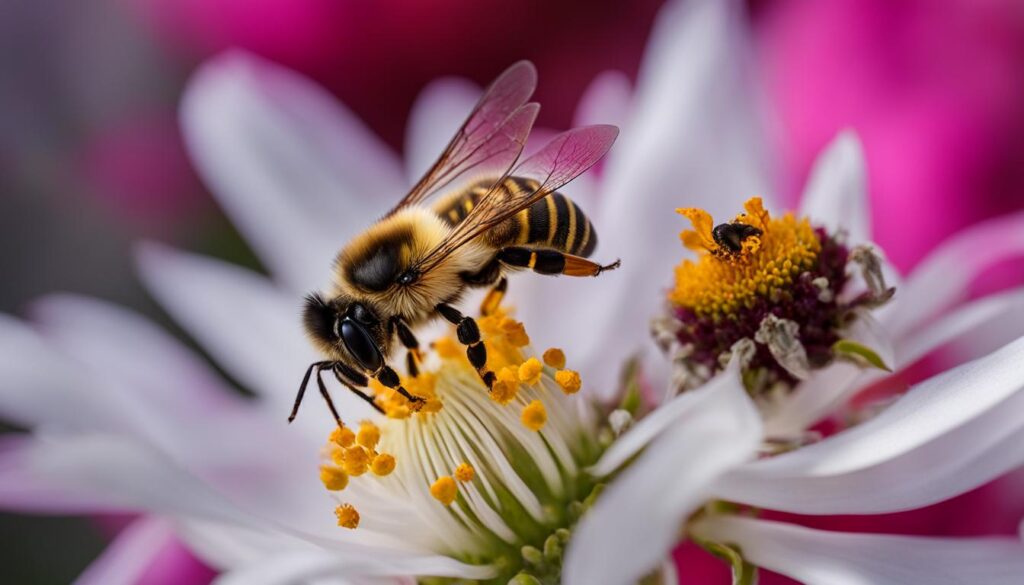
The Role of Bees in the Ecosystem
Bees play a crucial role in the ecosystem beyond their role in pollination. As they collect pollen and nectar, bees inadvertently transfer pollen from one flower to another, promoting genetic diversity in plant populations. This genetic diversity is essential for the survival and adaptation of plant species. Bees also serve as a food source for other animals, including birds and mammals. They contribute to the overall biodiversity of an ecosystem and help support the entire food chain. Without bees, many plant species would decline, leading to a cascade of negative effects on other species and the overall health of ecosystems.
Bees are not only important for sustaining plant populations, but they also provide crucial ecosystem services. They play a role in the decomposition of organic matter as they collect pollen and nectar from flowers. By doing so, they promote nutrient cycling and contribute to soil fertility. Bees also help control populations of insects that can be harmful to agricultural crops and other plant species. Their foraging behavior and consumption of insect pests contribute to the natural balance of ecosystems.
In addition to their ecological contributions, bees are also economically important. They are key pollinators for many crops that contribute to global food production and agricultural economies. The pollination services provided by bees are estimated to be worth billions of dollars each year. Without bees, crop yields would be significantly reduced, leading to higher food prices and potential food shortages.
Bees are vital for the sustainability of ecosystems and the global food supply. Their role in pollination ensures the reproduction and genetic diversity of plant populations, as well as the overall health and productivity of ecosystems. Conserving bee populations and their habitats is not only crucial for their survival but also for the well-being of the entire planet.
To summarize, bees play a multifaceted role in the ecosystem. They are not only efficient pollinators but also contribute to nutrient cycling, pest control, and the overall balance of ecosystems. Their importance extends beyond their ecological contributions, as they are essential for sustaining global food production and agricultural economies. Protecting and conserving bee populations is of utmost importance to ensure the long-term health and stability of ecosystems and the well-being of human societies.
The Decline of Bee Populations
Bee populations, both wild and managed, have been declining for several decades. The increased use of pesticides in agricultural and urban areas, as well as changes in land use, have contributed to the decline of bee communities. Colony collapse disorder, a phenomenon characterized by the mysterious disappearance of large numbers of honey bees, has raised concerns about the future of pollination and crop production. The decline of bee populations has significant implications for food security and agricultural sustainability. It is crucial to address the factors contributing to the decline of bee populations and implement practices that promote bee conservation, such as providing habitats free of pesticides, planting bee-friendly flowers, and preserving natural nesting resources.
| Factors contributing to the decline of bee populations: | Impact on pollination and crop production |
|---|---|
| 1. Increased use of pesticides | Reduces bee populations and affects their foraging behavior |
| 2. Changes in land use | Loss of natural habitats and food sources for bees |
| 3. Colony collapse disorder | Disrupts hive stability and leads to the loss of entire bee colonies |
| 4. Climate change | Alters flowering patterns and availability of nectar and pollen |
The decline of bee populations is a cause for concern not only because of the immediate impact on pollination and crop production but also because of the long-term consequences for the health of ecosystems. Bees are vital pollinators that ensure the reproduction of flowering plants and the genetic diversity of plant populations. Without bees, many plant species would decline, leading to a cascade of negative effects on other species and the overall stability of ecosystems. Protecting bee populations and preserving their habitats is essential for the sustainability of the natural environment and the health of the entire ecosystem.
“The decline of bee populations has significant implications for food security and agricultural sustainability.”
Addressing the decline of bee populations requires a multi-faceted approach. Reducing the use of pesticides, particularly those toxic to bees, is essential for their survival. Implementing sustainable agricultural practices that promote biodiversity and provide diverse food sources for bees can contribute to their conservation. Creating and preserving natural habitats, such as meadows, hedgerows, and bee-friendly gardens, can provide nesting sites and food resources for bees. Educating the public about the importance of bees and promoting bee-friendly practices, such as avoiding the use of pesticides in home gardens, can also make a positive impact. By working together to protect bee populations, we can ensure the future of pollination and maintain a healthy and sustainable ecosystem.
Bees and Their Nesting Habits
Bees have diverse nesting habits, with different species utilizing various materials and habitats for nest construction. Most bee species dig nests in soil, while others use plants or preexisting cavities. Some bees line their nest cells with a waxy material they produce themselves, while others use leaves, pebbles mixed with resin, or mud. Solitary ground-nesting species prefer to nest in soil, while bumble bees and feral honey bees may nest in abandoned rodent burrows or tree hollows. Nesting habitats for bees are crucial for their survival and reproduction. Providing suitable nesting resources, such as bare ground, dead tree trunks, and plant stems, can support bee populations and promote pollination in both agricultural and natural ecosystems.
Nesting Habits of Different Bee Species
Table: Bee Nesting Habits
| Bee Species | Nesting Material | Nesting Habitat |
|---|---|---|
| Solitary Bee | Waxy material, leaves, pebbles mixed with resin, mud | Soil, dead plant stems |
| Bumble Bee | Waxy material | Abandoned rodent burrows, tree hollows |
| Feral Honey Bee | Waxy material | Abandoned rodent burrows, tree hollows |
Each bee species has specific nesting requirements, reflecting their unique biology and ecological adaptations. For example, solitary bees, such as mason bees and leafcutter bees, build nests in soil or dead plant stems. They construct individual nest cells and provision them with pollen and nectar for their offspring. Bumble bees and feral honey bees, on the other hand, prefer nesting in preexisting cavities like abandoned rodent burrows or tree hollows. They create a colony with multiple bees and store honey and pollen as food reserves. Understanding the nesting habits of different bee species is crucial for designing conservation strategies and providing suitable nesting resources to support their populations.
By ensuring the availability of suitable nesting habitats, we can contribute to the protection and survival of bees. Creating areas with bare ground, leaving dead tree trunks intact, and providing plant stems as nesting sites can attract various bee species and promote their reproduction. These efforts not only benefit bees but also contribute to the overall health and stability of ecosystems by supporting pollination and the production of fruits, seeds, and other plant reproductive structures.
Bees’ Foraging Behavior
Bees have a complex foraging behavior that involves several stages of development. Female worker bees progress through different roles within the hive before becoming foragers. These roles include cleaners, undertakers, nurses, builders, temperature regulators, and guards. Once they reach the age of around 14 days, worker bees are ready to venture out as foragers.
They leave the hive at sunrise and visit flowers within a five-mile radius in search of nectar and pollen. Bees typically make multiple trips a day, visiting up to 100 flowers of the same species during each foraging trip. They have a highly developed sense of direction and can navigate based on the position of the sun and their exceptional visual skills.
The foraging behavior of bees is essential for their survival and the overall pollination process. It allows them to collect the necessary resources for themselves and their colony, ensuring the production of honey, food for their offspring, and the transfer of pollen between flowers for plant reproduction.
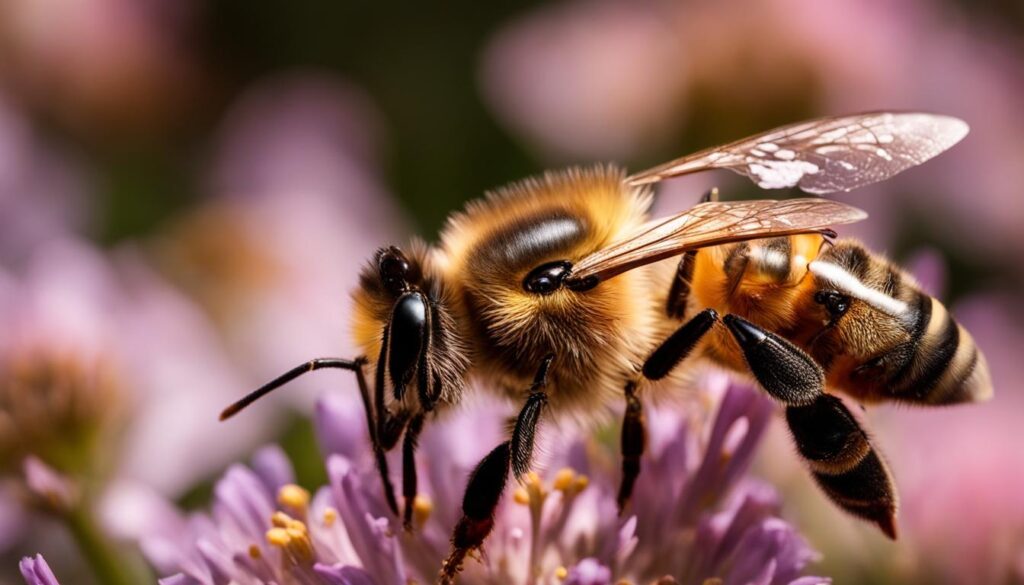
Bees’ Foraging Habits
Bees exhibit various foraging habits as they search for nectar and pollen. They are known to be highly selective, focusing on specific types of flowers, especially those that offer abundant nectar rewards. Bees are attracted to sweet-smelling flowers that indicate the presence of nectar, and their ability to perceive ultraviolet patterns guides them towards the center of the flowers.
“The foraging behavior of bees is a remarkable example of efficiency and precision in nature. Their ability to navigate, remember flower locations, and collect resources plays a crucial role in the pollination process and the survival of both bees and flowering plants.”
Additionally, bees have been observed to exhibit flower constancy, meaning they prefer to visit the same type of flower during a single foraging trip. This behavior increases the chances of successful pollination by ensuring that pollen from one flower is transferred to another flower of the same species.
Table: Comparison of Bee Foraging Habits
| Solitary Bees | Honey Bees | Bumble Bees | |
|---|---|---|---|
| Foraging Range | Short, within a few hundred meters | Medium, up to five miles | Long, up to six miles |
| Number of Flowers Visited | Varies, depending on species | Up to 100 per foraging trip | Up to 50 per foraging trip |
| Flower Constancy | Lower, visit a variety of flowers | Higher, exhibit flower constancy | Medium, exhibit some degree of flower constancy |
| Foraging Time | Varies, depending on species and environmental conditions | Throughout the day, starting at sunrise | Throughout the day, starting at sunrise |
Table: Comparison of bee foraging habits among different species of bees. The foraging range, number of flowers visited, flower constancy, and foraging time may vary depending on the species and environmental conditions.
Communication Among Bees
Bees have developed fascinating communication methods to share valuable information within their hive. One of the most intriguing forms of communication is the waggle dance. This dance is performed by foraging bees upon their return to the hive and conveys essential details about the location of food sources. Through the length and direction of the waggle dance, bees communicate the distance and angle of the food source relative to the sun. The vigor of the dance indicates the richness of the food supply, while physical contact with other bees allows the sharing of the flower’s scent. The waggle dance is a complex and visual method of communication that enables bees to effectively inform their fellow hive mates about valuable food sources.
“The waggle dance is a fascinating behavior that showcases the sophisticated communication abilities of bees. By sharing detailed information about food sources, bees ensure the efficient collection of resources for the entire colony. It is truly a remarkable example of how bees work together to benefit the entire hive.”
In addition to the waggle dance, bees possess exceptional visual skills that aid in their communication and foraging efforts. Bees can recognize different flower species, faces, and landmarks. Their keen visual abilities allow them to navigate based on visual cues and communicate the direction and location of food sources to other bees. These visual skills are crucial for their survival and the successful pollination of flowers.
Table: Communication Methods Among Bees
| Communication Method | Description |
|---|---|
| Waggle Dance | A complex dance performed by foraging bees to communicate information about the location of food sources to other bees. |
| Visual Skills | Bees possess exceptional visual abilities, allowing them to recognize different flower species, faces, and landmarks. |
Through the waggle dance and their remarkable visual skills, bees have developed a sophisticated system of communication within their colonies. These communication methods enable bees to effectively share information about food sources and contribute to the overall success of their hive.
How Flowers Attract Bees
Flowers have evolved specific features and adaptations to attract bees. They offer nectar and pollen as rewards to attract bees. Flowers that are open and easy for bees to access, such as those with a single row of petals and a wide open “mouth,” are particularly attractive to bees. Bright colors, especially blue, purple, and yellow, also catch the attention of bees. Bees are attracted to sweet-smelling flowers that indicate a high nectar content. The shape and structure of flowers, including landing platforms and tubular shapes with nectar at the base, further enhance their appeal to bees. The presence of ultraviolet patterns, known as nectar guides, assists bees in quickly locating the center of flowers. By attracting bees, flowers ensure the successful transfer of pollen and promote their own reproduction.
| Feature | How it Attracts Bees |
|---|---|
| Open Structure | Allows easy access for bees |
| Bright Colors | Catch the attention of bees |
| Sweet Smells | Indicates a high nectar content |
| Shape and Structure (landing platforms, tubular shapes) | Provides enhanced appeal and access to nectar |
| Ultraviolet Patterns (nectar guides) | Assist bees in quickly locating the center of flowers |
“The open structure and bright colors of flowers attract bees and provide easy access to nectar and pollen. Sweet-smelling flowers indicate a high nectar content, while the shape and structure of flowers, including landing platforms and tubular shapes, offer enhanced appeal and access to nectar. Ultraviolet patterns, known as nectar guides, assist bees in quickly locating the center of flowers. By attracting bees, flowers ensure the successful transfer of pollen and promote their own reproduction.”
Understanding how flowers attract bees is essential in appreciating the intricate relationship between these two organisms. The attractive features and rewards provided by flowers play a vital role in enticing bees and facilitating the pollination process. By creating a symbiotic relationship, flowers ensure their own reproduction and contribute to the overall health and biodiversity of ecosystems.
Bees’ Role in Plant Propagation and Genetic Diversity
Bees play a crucial role in plant propagation and the maintenance of genetic diversity within plant populations. Through their pollination efforts, bees ensure the fertilization of plant ovaries and the production of seeds, contributing to the overall success and survival of plant species. By transferring pollen from one flower to another, bees promote genetic recombination and the creation of hybrid varieties, enhancing the genetic diversity of plant populations.
Additionally, bees are essential agents of cross-pollination, which is necessary for some plant species to produce viable seeds. By visiting multiple flowers of the same species during their foraging trips, bees facilitate the efficient transfer of pollen, increasing the chances of successful pollination and seed production. This is particularly important for flowering plants that rely on outcrossing to avoid inbreeding and maintain genetic variability.
The contribution of bees to plant propagation and genetic diversity has far-reaching implications for the health and stability of ecosystems. Genetic diversity ensures the resilience and adaptability of plant species in the face of environmental changes, diseases, and pests. By promoting genetic recombination, bees help create plant populations that are better equipped to survive and thrive in various ecological conditions. Furthermore, the presence of a diverse range of plant species supports the overall biodiversity of ecosystems, providing habitat and food sources for a variety of other organisms.
Table: Examples of Bee-Pollinated Crops
| Crop | Importance |
|---|---|
| Apples | Major commercial crop |
| Almonds | Dependent on honeybee pollination |
| Blueberries | Reliant on bumblebee pollination |
| Squash | Dependent on native bee pollination |
| Strawberries | Benefit from various bee species |
By recognizing and valuing the vital role of bees in plant propagation and genetic diversity, we can ensure the preservation and conservation of bee populations. Protecting bee habitats, reducing the use of pesticides, and promoting sustainable agricultural practices are essential steps in safeguarding the pollination services provided by bees. By doing so, we not only support the health and productivity of our ecosystems but also secure the future of our food supply.
Conclusion
Bees play a crucial role in the process of pollination, allowing for the reproduction of flowering plants and the production of fruits and seeds. Their efficient foraging behavior and specialized collecting techniques ensure the transfer of pollen between flowers, promoting genetic diversity within plant populations. This genetic diversity is essential for the resilience and adaptability of plant species, supporting the overall health and stability of ecosystems.
Not only do bees contribute to plant propagation, but they also play a significant role in the ecosystem as a whole. By inadvertently transferring pollen as they collect nectar and pollen, bees promote genetic diversity in plant populations, thus benefiting other species that rely on these plants for their survival. Bees also serve as a vital food source for other animals, contributing to the overall biodiversity and food chain of an ecosystem.
However, bee populations are facing decline due to factors such as pesticide use and habitat loss. To ensure the continued health of ecosystems and the sustainability of our food supply, it is crucial to recognize the importance of bees and take steps to protect and conserve their populations. Supporting bee-friendly practices, such as providing pesticide-free habitats and planting bee-attracting flowers, can make a significant impact in preserving these important pollinators.
FAQ
What is the role of bees in pollination?
Bees play a vital role in pollination by transferring pollen from the male parts of a flower to the female parts, which is essential for fertilization and seed production.
How do bees collect pollen?
Bees collect pollen as a source of protein by using their specialized brushes and body parts to groom the pollen onto their legs or into specialized pockets.
Why is cross-pollination important?
Cross-pollination, or the transfer of pollen between flowers of the same species, is necessary for the production of viable seeds and genetic diversity within plant populations.
Why are bees attracted to flowers?
Bees are attracted to flowers that offer nectar as a reward for their pollen collection efforts. They use their sense of smell and visual cues to locate flowers with high nectar content.
How do bees contribute to the ecosystem?
Bees not only play a crucial role in pollination but also promote genetic diversity in plant populations and serve as a food source for other animals, supporting the overall biodiversity of an ecosystem.
Why are bee populations declining?
Bee populations are declining due to factors such as pesticide use, habitat loss, and phenomena like colony collapse disorder, which poses a threat to pollination and crop production.
Where do bees build their nests?
Bees have diverse nesting habits, with some species nesting in soil, others using plants or preexisting cavities, and some preferring tree hollows or abandoned rodent burrows.
How do bees forage for nectar and pollen?
Worker bees leave the hive at sunrise and visit flowers within a five-mile radius. They make multiple trips a day, visiting up to 100 flowers of the same species during each foraging trip.
How do bees communicate with each other?
Bees communicate important information, such as the location of a food source, through complex dances known as waggle dances. They also have exceptional visual skills and use scent to share information.
How do flowers attract bees?
Flowers attract bees through various features and adaptations, including offering nectar and pollen rewards, bright colors like blue and yellow, and shapes that make it easy for bees to access the nectar.
Why is bee pollination important for plants?
Bee pollination is essential for plant propagation and the production of viable seeds. It promotes genetic diversity within plant populations, ensuring the resilience and adaptability of plant species.

